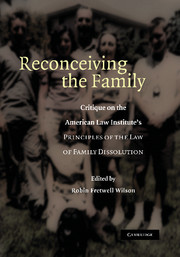 Reconceiving the Family
Reconceiving the Family Book contents
- Frontmatter
- Contents
- Acknowledgments
- Foreword, by Mary Ann Glendon
- List of Contributors
- Introduction
- PART ONE FAULT
- PART TWO CUSTODY
- PART THREE CHILD SUPPORT
- PART FOUR PROPERTY DIVISION
- PART FIVE SPOUSAL SUPPORT
- PART SIX DOMESTIC PARTNERSHIP
- 14 Domestic Partnership and Default Rules
- 15 Private Ordering under the ALI PRINCIPLES: As Natural as Status
- 16 Marriage Matters: What's Wrong with the ALI's Domestic Partnership Proposal
- 17 Domestic Partnerships, Implied Contracts, and Law Reform
- PART SEVEN AGREEMENTS
- PART EIGHT JUDICIAL AND LEGISLATIVE PERSPECTIVES
- PART NINE INTERNATIONAL REFLECTIONS
- Afterword: Elite Principles: The ALI Proposals and the Politics of Law Reform, by Carl E. Schneider
- Index
14 - Domestic Partnership and Default Rules
Published online by Cambridge University Press: 25 January 2010
- Frontmatter
- Contents
- Acknowledgments
- Foreword, by Mary Ann Glendon
- List of Contributors
- Introduction
- PART ONE FAULT
- PART TWO CUSTODY
- PART THREE CHILD SUPPORT
- PART FOUR PROPERTY DIVISION
- PART FIVE SPOUSAL SUPPORT
- PART SIX DOMESTIC PARTNERSHIP
- 14 Domestic Partnership and Default Rules
- 15 Private Ordering under the ALI PRINCIPLES: As Natural as Status
- 16 Marriage Matters: What's Wrong with the ALI's Domestic Partnership Proposal
- 17 Domestic Partnerships, Implied Contracts, and Law Reform
- PART SEVEN AGREEMENTS
- PART EIGHT JUDICIAL AND LEGISLATIVE PERSPECTIVES
- PART NINE INTERNATIONAL REFLECTIONS
- Afterword: Elite Principles: The ALI Proposals and the Politics of Law Reform, by Carl E. Schneider
- Index
Summary
The domestic partnership chapter of the Principles “both over-and undershoots its target.” That is, by assuming cohabitation and marriage were similar, but only legislating for the limited purpose of dissolution, the Principles create a default rule that few would want. As may be obvious from their title, the Principles do not attempt to directly influence ongoing family relationships. Thus, “In view of the scope of these Principles, Chapter 6 is limited to the following question: What are the economic rights and responsibilities of the parties to each other at the termination of their nonmarital cohabitation? Chapter 6 does not create any rights against the government or third parties.” Unprotected parties who would marry if they were able to (and for whom the chapter was presumably intended) would not get enough relief because there would be no protection upon death of one of them, nor is there a requirement of mutual support during the relationship. This stands in contrast to the Canadian rule, as Canadian law still enforces the duty to support during the “common law” relationship. Moreover, parties who did not want to get married but wanted to cohabit would find themselves with a set of responsibilities on dissolution that they did not want to assume; if they had wanted these responsibilities, they would have married. Contrast this with Norway, where about 25 percent of couples are unmarried, but “[u]nlike married couples, cohabiting couples have no legal responsibility to provide for each other.
- Type
- Chapter
- Information
- Reconceiving the FamilyCritique on the American Law Institute's Principles of the Law of Family Dissolution, pp. 269 - 283Publisher: Cambridge University PressPrint publication year: 2006
